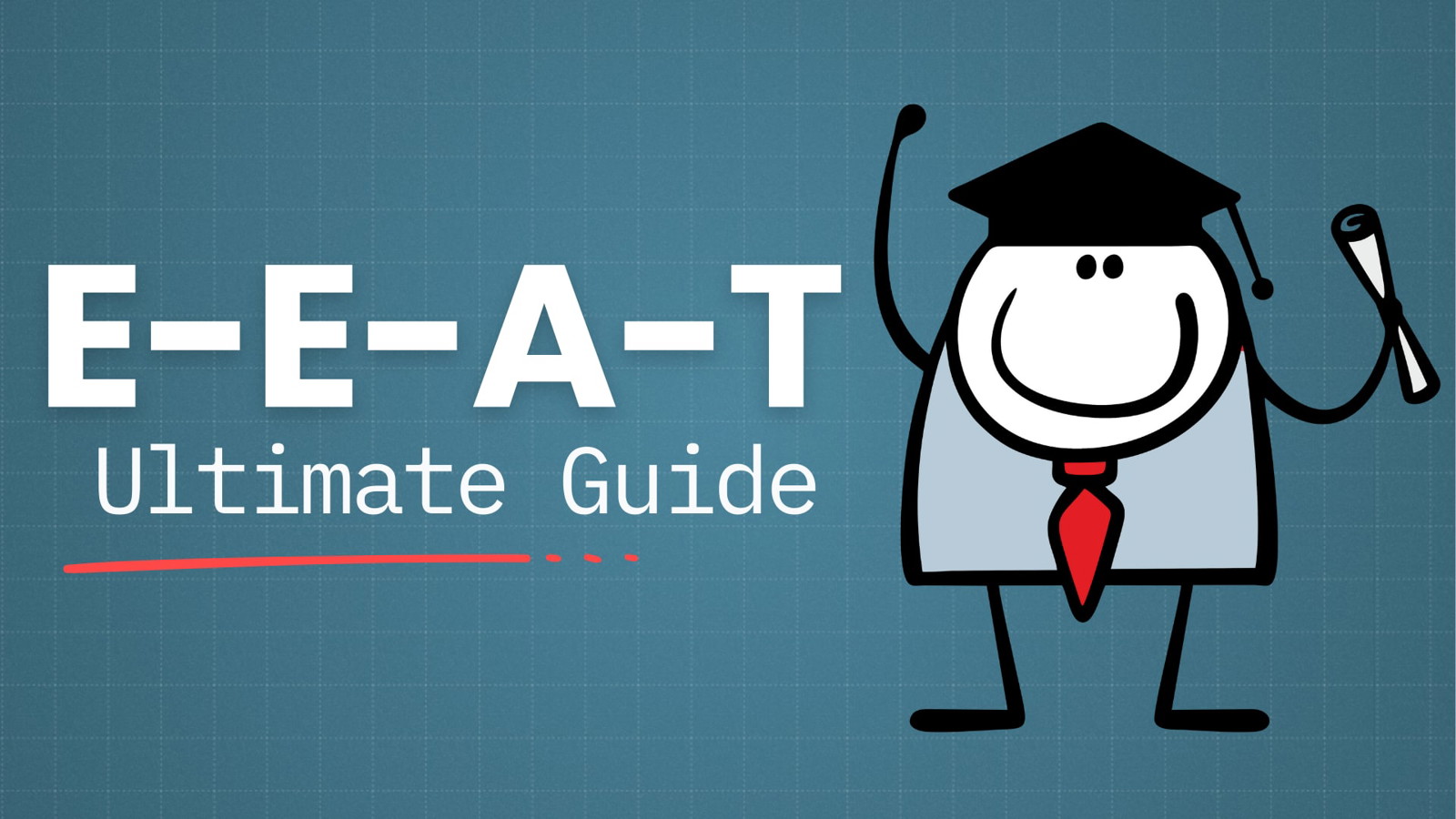You’re starting a blog, but your ideal .com domain is taken.
Don’t worry – there are plenty of legit .com alternatives out there. And ones that can actually help with your branding efforts.
If you haven’t totally given up on finding a .com domain, though, I recommend you check the video below and our new AI domain-finding tool: Brandsnap.ai.
However, if you still can’t find the perfect .com domain, we’ll explore the top 10 options and reveal how to use them to build your brand. Plus, we’ll discuss choosing the perfect domain name and the SEO impact of non-.com domains.
But first, let’s get right into that list of .com alternatives.
1 .IO Domains
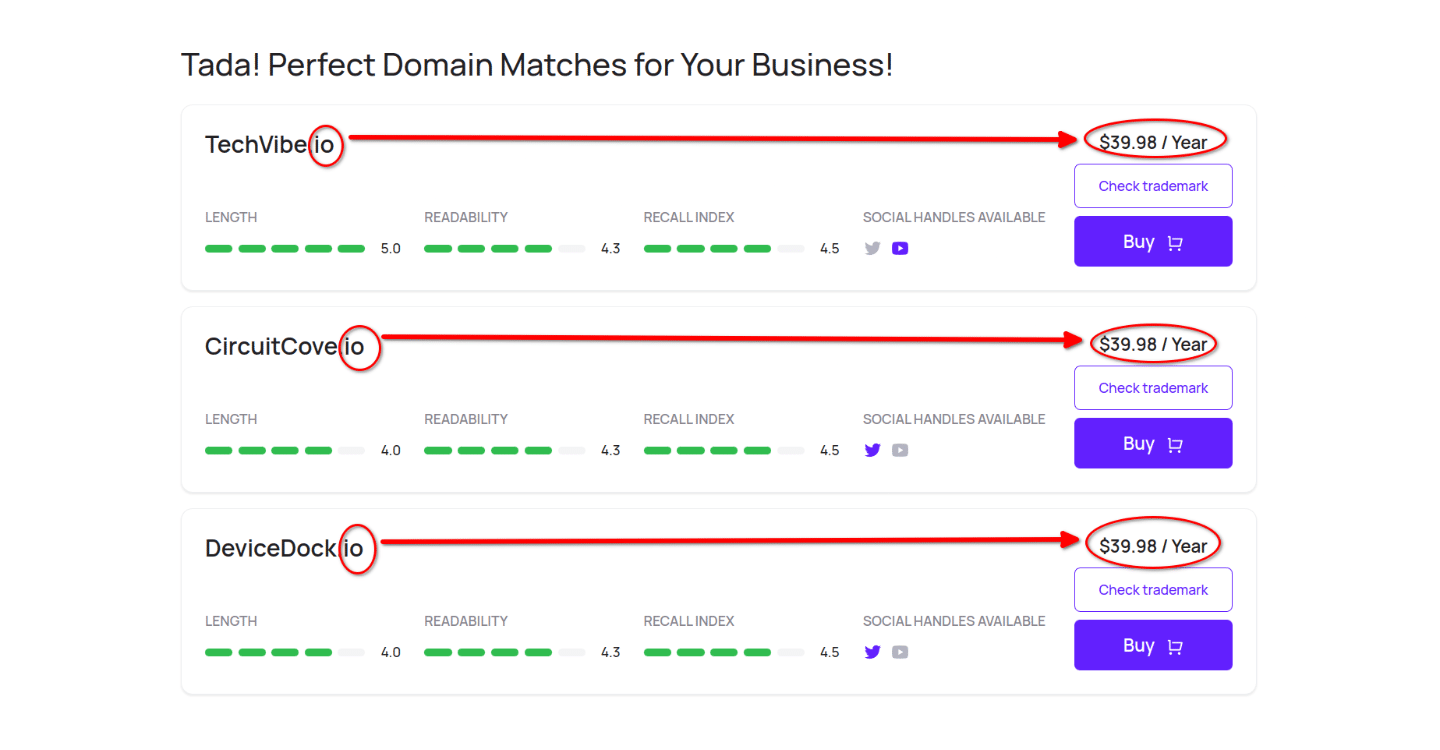
When to use: Webapps, SaaS, online games, interactive websites, tech-related websites
Avg. pricing: $40/year
The .io domain extension is all the rage, particularly among tech companies and tech startups. It does have a tech vibe to it, doesn’t it? IO or I/O – abbreviation of input-output.
Surprisingly, .io is actually a geographical domain like .us and .uk. It was assigned to the British Indian Ocean Territory.
However, the alternative domain gained popularity in the tech niche, with several successful websites using it. A few examples include:
- Slither.io: An addictive online multiplayer game.
- Codepen.io: A social development environment for front-end developers.
- Sentry.io: An error-tracking tool for real-time monitoring and repairs.
- Ssstik.io: A TikTok video downloader.
- Itch.io: An open marketplace for independent digital creators.
2 .CO Domains

When to use: Website for companies, corporations, communities, and also websites targeting Colombian audiences
Avg. pricing: $30/year
Originally intended for Colombian websites, .co has evolved into a popular alternative domain to .com. Why? It’s strikingly similar to .com, minus one letter, making it highly memorable.
Often, “co” stands for company, corporation, or community. If your website aligns with these connotations and .com is off the table, .co could be your next best bet.
Consider these successful .co websites:
- Brit.co: An online community for creative learning.
- Carrd.co: A platform for building simple, responsive, one-page sites.
- Lever.co: A modern recruiting software and applicant tracking system.
- Flashscore.co: A sports live scores service.
- Vsco.co: A creative channel and photo editing app.
3 .NET Domains
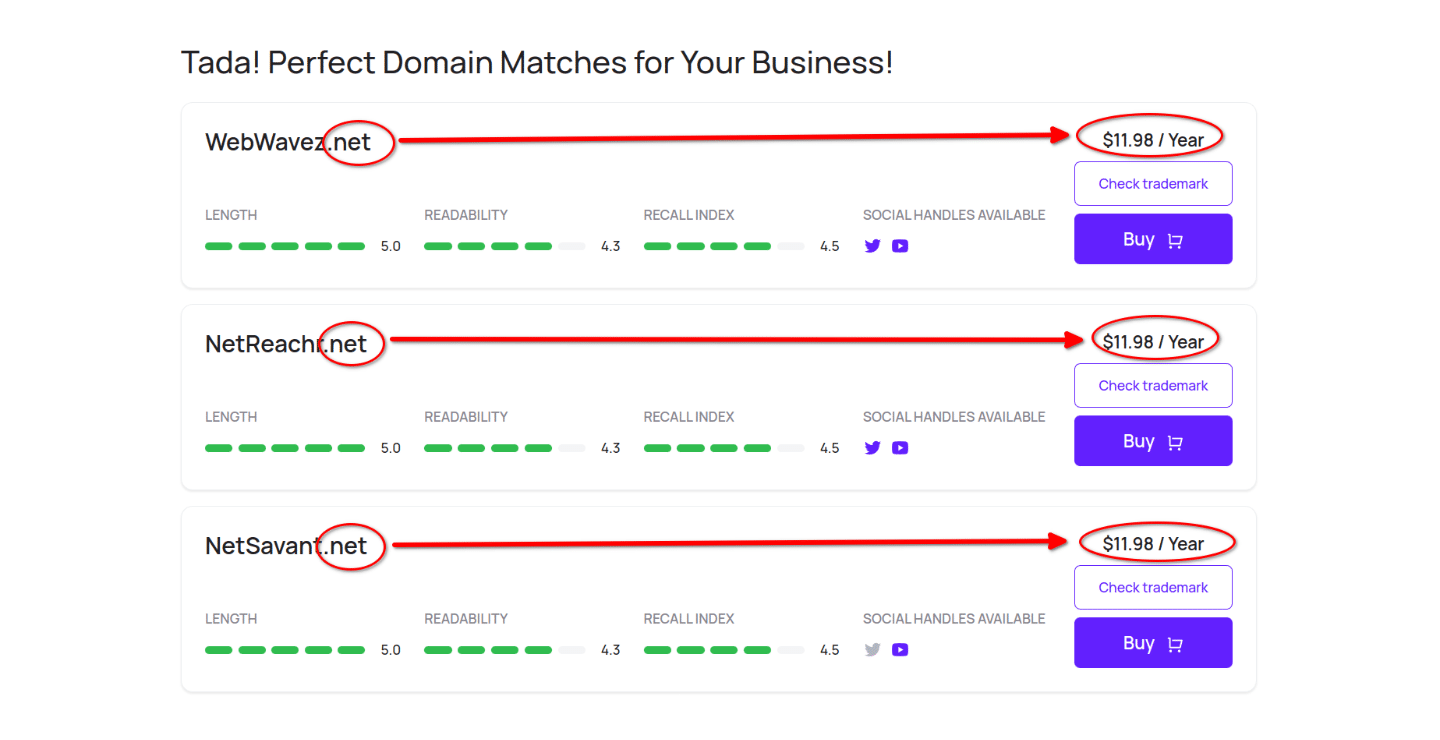
When to use: Websites related to networking, internet infrastructure, database services, online communities, and tech-based companies
Avg. pricing: $12/year
The .net domain extension, one of the original public options alongside .com, has long been a go-to option for companies involved in networking and related technologies.
It’s also a popular choice for tech-based communities.
Authoritative and memorable, .net is a trusted .com alternative.
Just ensure that if you do decide to use the .net extension, your site aligns with networking or communities, as that’s what most people expect when visiting a .net domain.
To give you a clearer picture, let’s take a look at some popular .net websites:
- Php.net: The official website for PHP, a popular scripting language.
- Battle.net: An online gaming platform developed by Blizzard Entertainment.
- Behance.net: A platform for showcasing and discovering creative work.
- Speedtest.net: A service that provides free analysis of Internet access performance.
- Sourceforge.net: A web-based service that offers software developers a centralized online location to control and manage free and open-source software projects.
- Slideshare.net: A hosting service for professional content, including presentations, infographics, documents, and videos.
4 .BLOG Domains

When to use: Blogs, content-focused websites, corporate blogs, content hubs for businesses
Avg. pricing: $25/year
Despite being introduced in 2016, the .blog domain name extension quickly gained traction among bloggers and content creators worldwide.
Its popularity stems from its clear messaging— this is a blog.
The .blog extension is an excellent choice for writers, journalists, and content creators. It also works well for corporate blogs or content hubs for businesses.
If you plan to start a blog or content-focused website, you can safely embrace the .blog extension. Here are a few examples of popular .blog websites:
- Tim.blog: The blog of Tim Ferriss, author of “The 4-Hour Workweek”.
- Github.blog: The official blog of Github, a platform for software development.
- Stackoverflow.blog: The blog of Stack Overflow, a platform for learning and sharing knowledge about programming.
- Micro.blog: A platform that encourages short-form blogging.
- Seths.blog: The blog of Seth Godin, a best-selling author, and entrepreneur.
5 .SHOP Domains

When to use: Exclusively eCommerce websites, an online storefront for physical stores, marketplace
Avg. pricing: more than $30/year
Also introduced in 2016, the .shop domain extension clearly communicates it’s an eCommerce website. It’s a popular choice for online retailers selling products or services.
Unlike content-driven websites, .shop sites focus primarily on commerce. You won’t find many blog posts, except for occasional support documents or FAQs about the products/services offered.
To get a better idea if it’s right for your needs or not, check out these popular .shop websites:
- Nakedlab.shop: A website selling bio-leather baby mats.
- Beautyemporium.shop: A beauty products eCommerce platform.
- Alienation.shop: An online clothing store.
- Balsamico.shop: An online store selling Balsamic vinegar.
6 .AI Domains
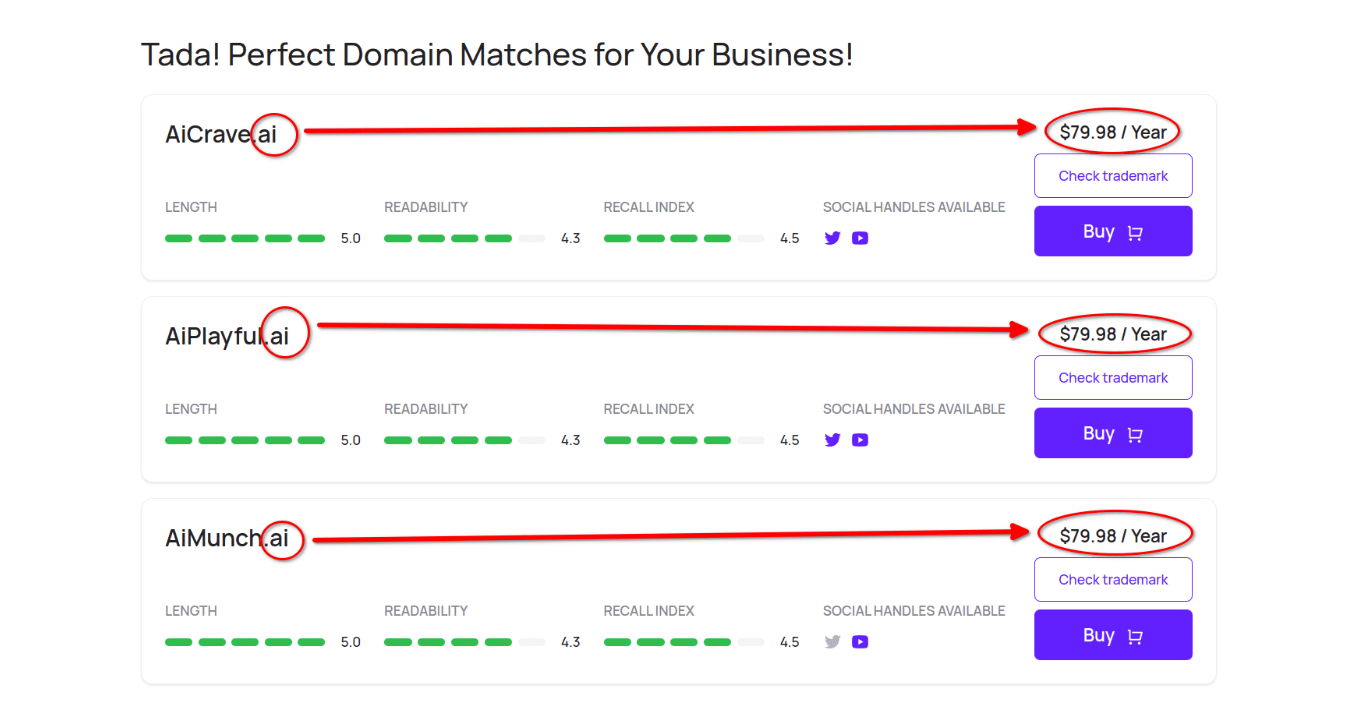
When to use: Websites related to AI projects, AI news, AI services, and even AI communities
Avg. pricing: $80/year
Think .ai is exclusively for AI (Artificial Intelligence)? Plot twist: it’s actually a country code extension for Anguilla, an Eastern Caribbean British Overseas Territory.
Despite its geographical origin, the extension has become internationally popular thanks to all the buzz surrounding AI right now.
Whether you’re an AI service provider, an informational site, a research hub, an event platform, or a community for AI enthusiasts, the .ai extension could be a perfect fit.
Here are some popular websites that use the .ai extension:
- Jasper.ai: An AI writing assistant.
- Copy.ai: An AI-powered copywriting tool.
- Bodyguard.ai: An AI tool for moderating online content.
- Deeplearning.ai: An educational resource for Deep Learning.
- Designs.ai: An AI-powered graphic design tool.
7 .ME Domains

When to use: Personal blogs, portfolios, personal brand websites, cleverly drafting action-oriented domain names
Avg. pricing: $20/year
Ah, .me, the extension designed for individuals to showcase their lives and build a personal online presence. Only .me is yet another country-code extension. This time for the Balkan country, Montenegro.
Now the .me extension does see some uses by websites targeting audiences in Montenegro. That said, if you’re building a website focused on a personal brand and you plan to talk about your life, your projects, and your achievements, then .me can be the perfect option.
Another innovative use for .me is crafting action-oriented domain names. This clever branding strategy communicates the website’s purpose while keeping it memorable.
Here are a few example sites to give you an idea of what I’m talking about:
- Relocate.me: A job board for tech professionals looking to relocate.
- About.me: A personal web hosting service.
- Hide.me: A VPN provider.
- Speedof.me: An internet speed test service.
- Id.me: A digital identity network that allows for secure, privacy-preserving interactions online.
8 .BIZ Domains

When to use: Business-oriented websites, B2B websites, business-centric content, and news websites.
Avg. pricing: $15/year.
The .biz extension was introduced specifically for business websites. It’s like a neon sign announcing to visitors: “We’re a functioning business!”
If your site is associated with a company or corporation, the .biz domain could be a perfect fit.
Sure, .co might be more popular and serve a similar purpose, but .biz offers clearer messaging. Plus, unlike .co, .biz doesn’t carry any geographical connotations.
Here are some popular websites that use the .biz extension:
- Daplomb.biz: A website for a design and marketing agency.
- Rollingscones.biz: An ice cream shop’s website.
- Visualist.biz: A website for a visual marketing company.
- Mpdesign.biz: A website for a design studio.
- Gamesindustry.biz: A website providing news and insights about the gaming industry.
9 .ORG Domains
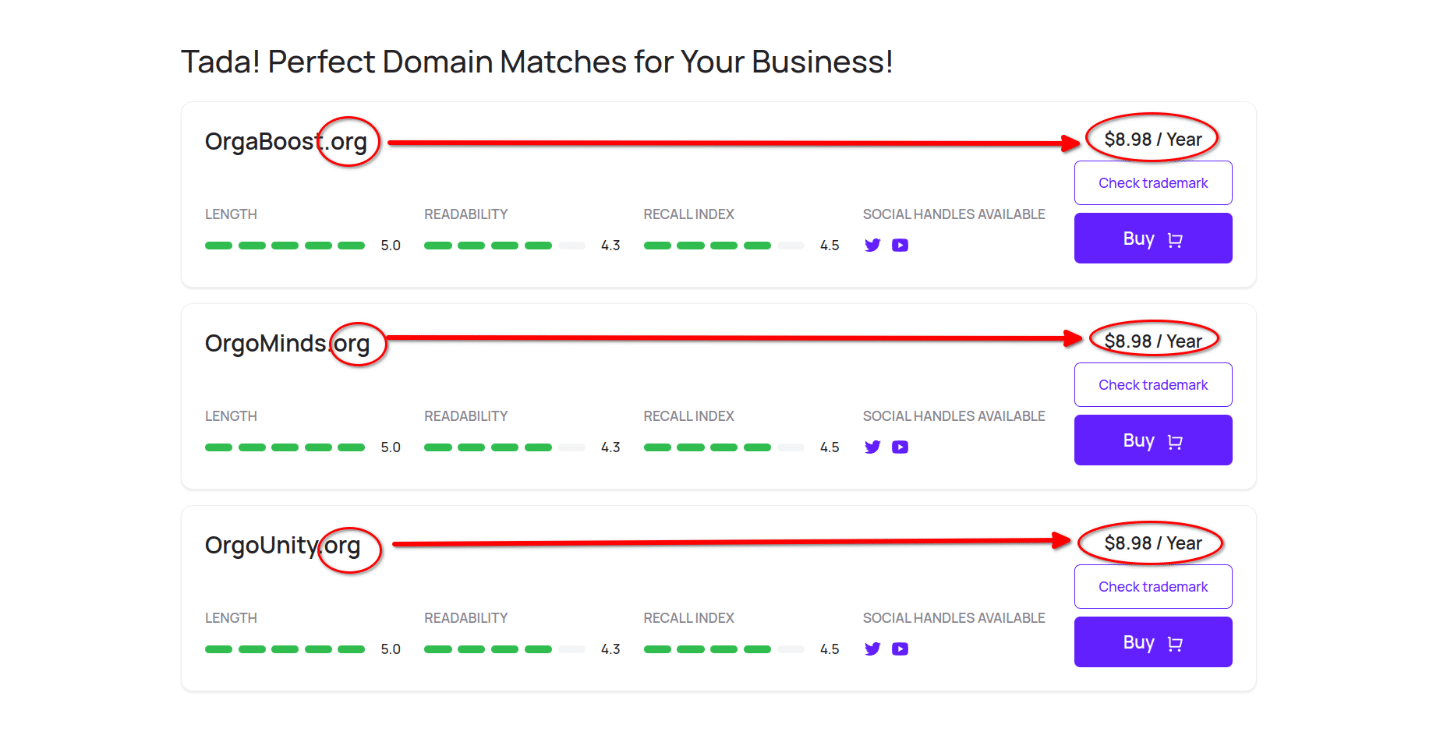
When to use: Non-profit organizations, educational institutions, research organizations, cultural institutions, museums, or any website that wants to showcase themselves as an organization
Avg. pricing: Less than $10/year
The .org extension is one of the original domain extensions alongside .com and .net. It’s a go-to choice for big communities and public interest projects. Because of this, it has a lot of trust and popularity among the masses.
The .org extension is mostly associated with websites centered around non-profit organizations and charities. It’s also used by educational institutions, research organizations, cultural institutions, and even museums.
Here are some popular websites that use the .org domain extension:
- Freecodecamp.org: A non-profit organization that consists of an interactive learning web platform.
- Coursera.org: An American online learning platform that offers massive open online courses (MOOC).
- Edx.org: A provider of massive open online courses.
- Python.org: The official website for the Python programming language.
- Imf.org: The official website of the International Monetary Fund.
- Unesco.org: The official website of the United Nations Educational, Scientific and Cultural Organization.
10 Country Code Domains
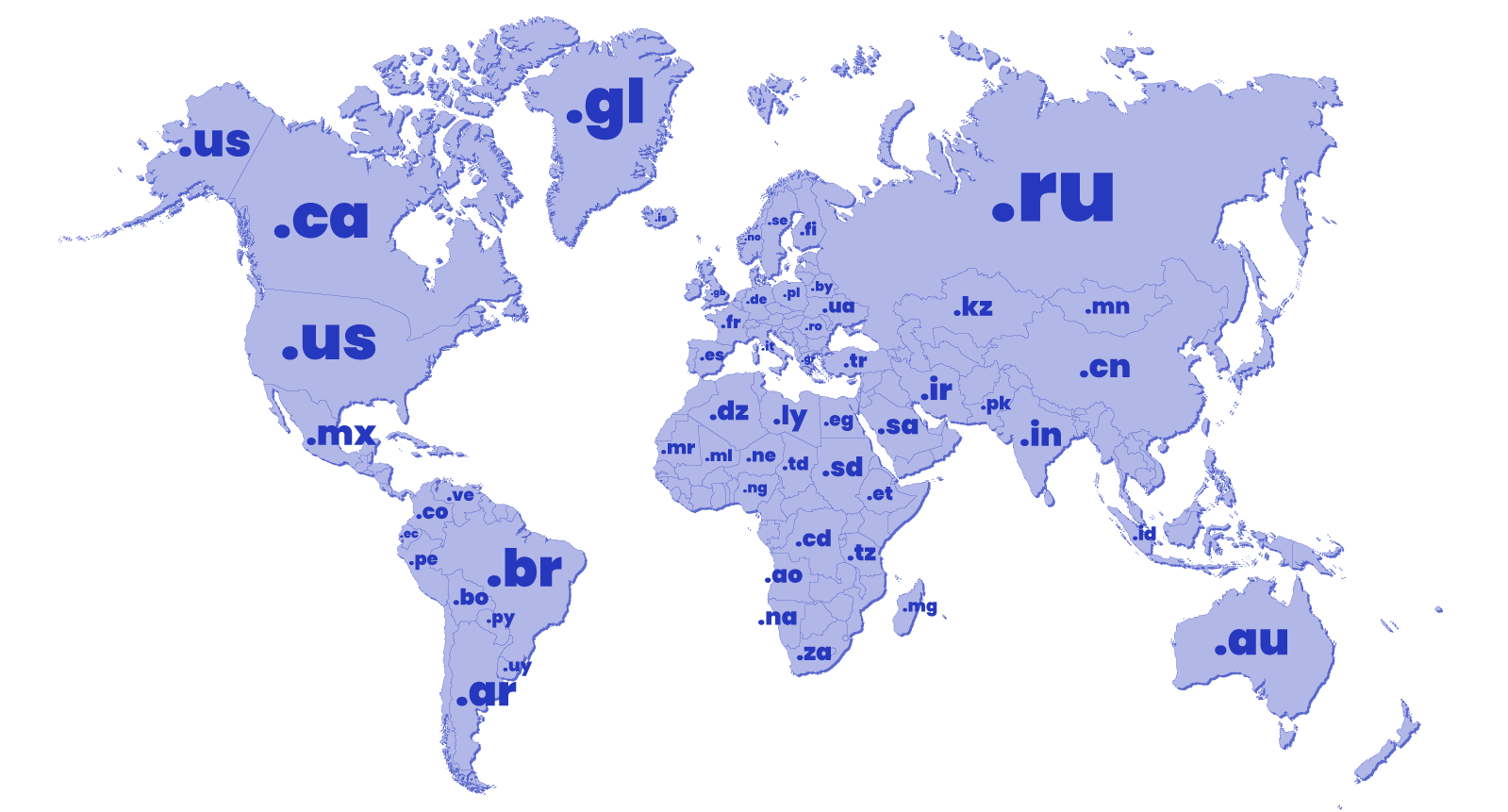
When to use: When you’re website is targeting a specific region, and you don’t want to target a global audience
Avg. pricing: Varies based on the specific country and domain name registrars
Country code domain, also known as Country-code Top-Level Domains (ccTLD), represents a collection of all domain name extensions designed for websites targeting specific countries.
However, as you’ve seen, many ccTLDs (like .io, .co, .ai, .me, etc.) have alternative usage based on how they are spelled or written. For reference, here’s the Wikipedia link for all ccTLDs currently in use.
ccTLDs are generally trusted more and seen as reliable or authoritative sources if the audience is from the same country as the ccTLD specifies.
For example, Amazon uses different ccTLDs for its websites targeting different countries:
- Amazon.de for Germany
- Amazon.fr for France
- Amazon.in for India
- Amazon.ca for Canada
- Amazon.mx for Mexico
And so on.
Also, some countries use Second-Level Domains (SLDs) with their TLDs, such as .co.uk in the UK or .co.in in India. This is typically done to indicate that the website is a commercial entity, not associated with the country’s government. The .co here communicates “commercial.”
What are TLD Domains and Why Do They Matter?
TLD, short for Top-Level Domain, refers to the final section or the end of a domain name.
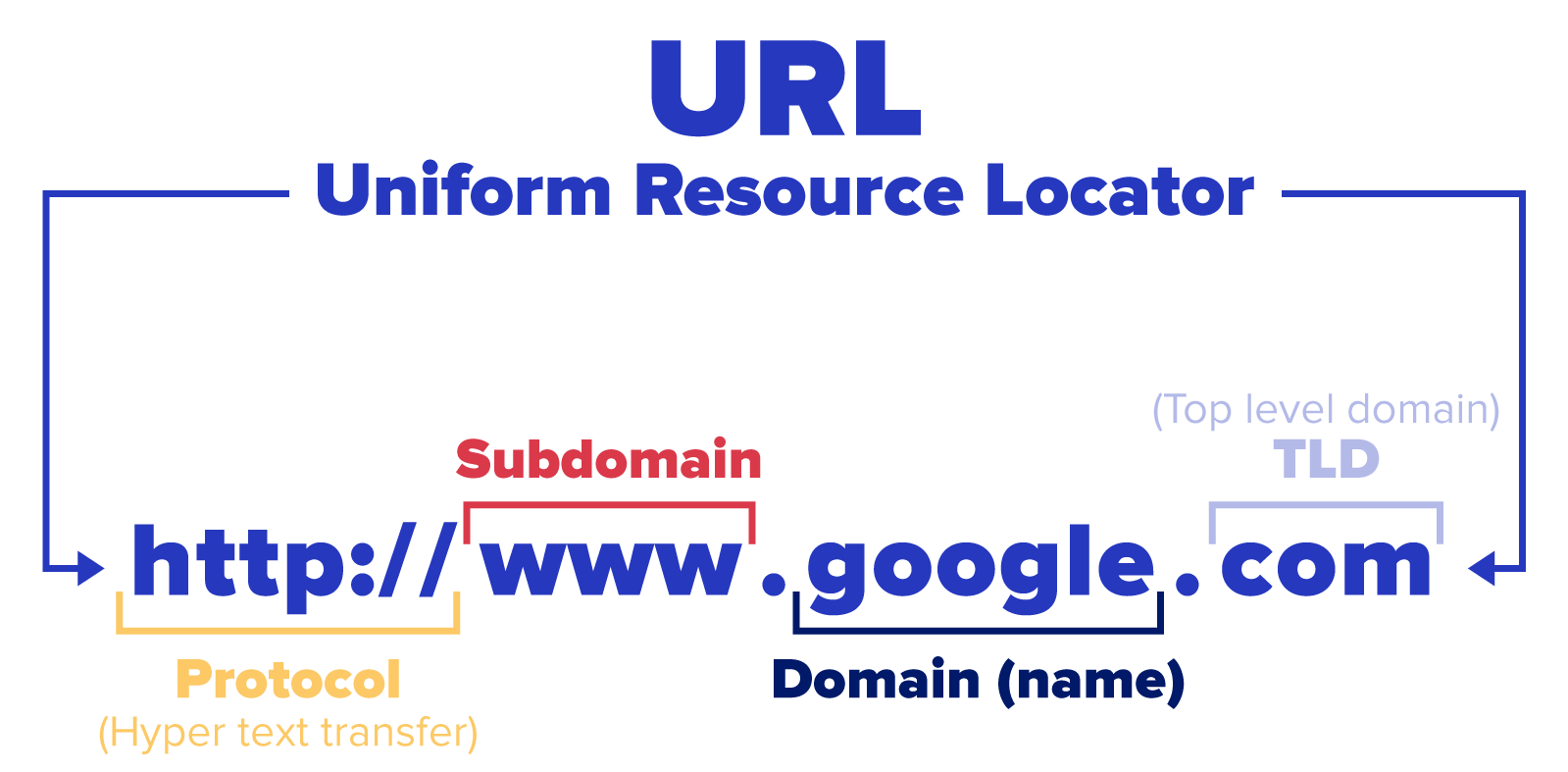
So, in the case of www.example.com, we have
- Dot com is the Top-Level Domain
- Example is the domain name, also called the Second-Level Domain here
- WWW is the subdomain, also called the Third-Level Domain
Likewise, if we consider www.blog.example.co.uk, we have:
- .uk is the Top-Level Domain
- .co is the Second-Level Domain
- Example is the Third-Level Domain
- Blog is the Fourth-Level Domain
- WWW is the Fifth-Level Domain
These top-to-bottom levels help to build the hierarchical structure of the Domain Name System (DNS).
TLDs play a crucial role in the organization and classification of the internet. They help to identify the nature of the website (commercial, educational, governmental, etc.) and also the geographical location the website is targeting.
A Brief History of TLD Domains
In the early days of the internet, visiting a website required typing in an IP address. As the number of websites grew, remembering these numbers became impractical.
Enter, Paul Mockapetris, the computer scientist who invented the Domain Name System (DNS), replacing numeric addresses with memorable names and introducing a hierarchical structure for better organization.
Interestingly, you can still visit websites using their IP address.
For example, Google.com can be accessed by typing in its IP address, 142.250.64.78 as the web address.
About .COM Domains
Dot com (.com) has always been the most popular extension. This is because .com was one of the first TLDs introduced for public use. It’s a shorthand for “commercial” and could be used by non-government affiliated websites focusing on making a profit.
Currently, over 50% of all websites on the World Wide Web use the .com domain.
The massive popularity comes with its own set of advantages and disadvantages.
.com TLD Pros
Familiarity and Trustability: They are more common and familiar, making them more trustworthy.
Global Recognition: They are globally recognized and allow you to target a global audience.
Memorability: They are short and easy to remember. I know I mistakenly default to typing .com as the TLD for even non-.com websites.
.com TLD Cons
Limited Availability: Because .com has been in the game for so long, most good domain names are already taken. The problem is further amplified when people just buy and hold .com domains to sell them for a profit.
Lack of Local Relevance: A .com domain won’t make it clear that you only serve a particular audience of a particular country. There’s no local relevance.
Generic: The domains are “too” popular, making them somewhat generic. It doesn’t provide enough information for people to understand what the site is about. Is it a blog? Is it a SaaS? What is it??
How Different TLD Domains Affect Rankings on Search Engines?
You might have heard marketers or SEO “gurus” claim that .com is the “only” TLD you should use, and any other will harm your search engine rankings. Well, let’s debunk that myth right now.
Google has repeatedly stated that a website’s TLD isn’t a ranking factor.
However, there’s a caveat! Some TLDs, especially cheaper ones, have been misused by spammers and scammers, leading to a general distrust for these extensions.
If you choose one of these less trusted TLDs, internet users might be skeptical about your site, leading to high bounce rates and low time on site. And guess what? Those are ranking factors for search engines, and Google treats them very seriously.
So, while your TLD doesn’t directly affect your SEO, it can have an indirect impact. The solution? Stick to reputable TLDs (the ones I mentioned above) to avoid any potential pitfalls.
How to Pick Good Domain Names
So yeah, picking the right TLD is important. But you know what? Picking the right domain name is even more important because that’s essentially the name of your website.
Now, if you’re having trouble coming up with a good and catchy domain name, here are a few tips to help you out:
Use short and memorable names: Shorter names, between 6-14 characters, are easier to type and remember.
Easy to spell and read: Avoid using the same consecutive letters, hyphens, and numbers in your domain name, as they can confuse users.
Use alliteration, rhymes, assonance, and consonance: These linguistic techniques can make your domain name catchy and memorable. For example, “Coca-Cola” uses alliteration, “StubHub” uses rhymes, “YouTube” uses assonance, and “Bitly” uses consonance.
Use common phrases or idioms: A common phrase or idiom can make your domain name instantly recognizable and memorable.
Use personal names: If you’re building a personal brand, using your own name can be a good choice.
Include buzzwords: If there are buzzwords relevant to your industry, consider incorporating them into your domain name.
Read it aloud: Once you pick a domain name, read it aloud, repeatedly. You don’t want TeachersTalking.com to be pronounced as TeacherStalking.com, now do you?
Read it aloud: Once you pick a domain name, read it aloud, repeatedly. You don’t want TeachersTalking.com to be pronounced as TeacherStalking.com, now do you?
Avoid keyword stuffing: Avoid stuffing your domain name with keywords. It can make your domain name look spammy.
Social media availability: Check if your chosen domain name is available on social media platforms. Consistency across platforms can strengthen your brand.
Check for trademarks: If your domain is trademarked, it could lead to legal issues in the future.
Use BrandSnap.ai to Find the Best Domain Names
Admittedly, finding the perfect domain name can take up a lot of time between brainstorming and checking availability. Fortunately, BrandSnap.ai automates this process for free.
Simply visit the website, and enter the topic of your blog or website in the text field. Hit the “Advanced Settings” to pick the “Style” and what TLDs you want in your recommendation.
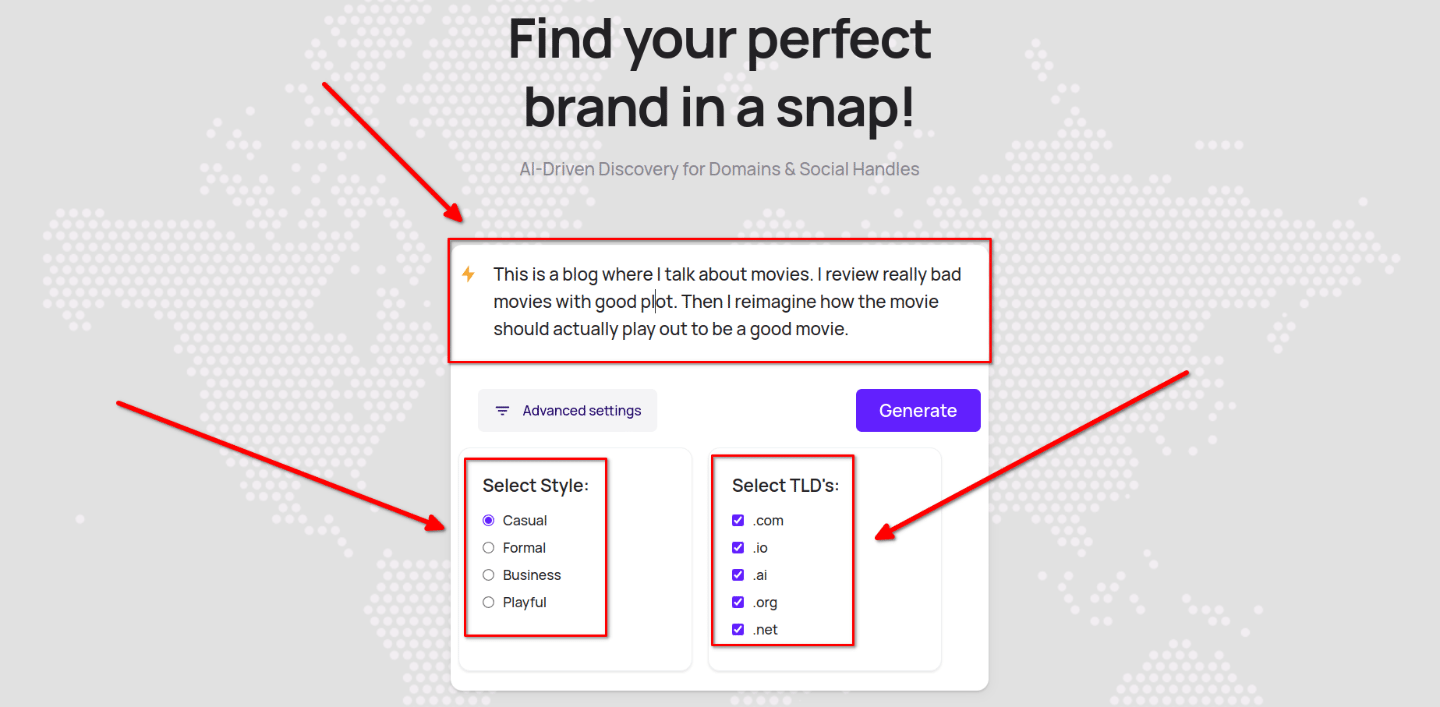
Once done, hit “Generate,” and that’s it.
BrandSnap employs AI and NLP (Natural Language Process) to understand what your website is about and then generates a long list of awesome, brand-perfect domain names.

It’ll also showcase social handle availability, check for trademarks, and rate the length, readability, and memorability of the domain name.
Once you zone in on a particular name that you like, click on the “Buy” button, and it’ll take you right through to Namecheap to purchase your domain.
Conclusion
Long story short, if the coveted .com domain is not available for your desired name, don’t fret. Switching to a different TLD is a viable strategy, provided it’s a trusted and recognized TLD. In fact, choosing the right TLD can even enhance your branding if it aligns well with your website’s purpose and audience.
To recap, here are some of the reputable .com alternative domains you can consider using:
- .io
- .co
- .net
- .blog
- .shop
- .ai
- .me
- .biz
- .org
- Country TLDs
That said, TLD comes later. First, you need to pick a good domain name, and for that, you can use BrandSnap.ai. This free, AI-powered tool can generate a list of potential domain names based on your website’s topic.
Not only can it help you find a unique .com domain name, but it can also suggest names that are short, easy to read, and memorable. Plus, it displays available social media handles and allows you to check for trademarks, making it a comprehensive solution for your branding needs.
Remember, your domain name is your online identity. Choose wisely, and make it count!




